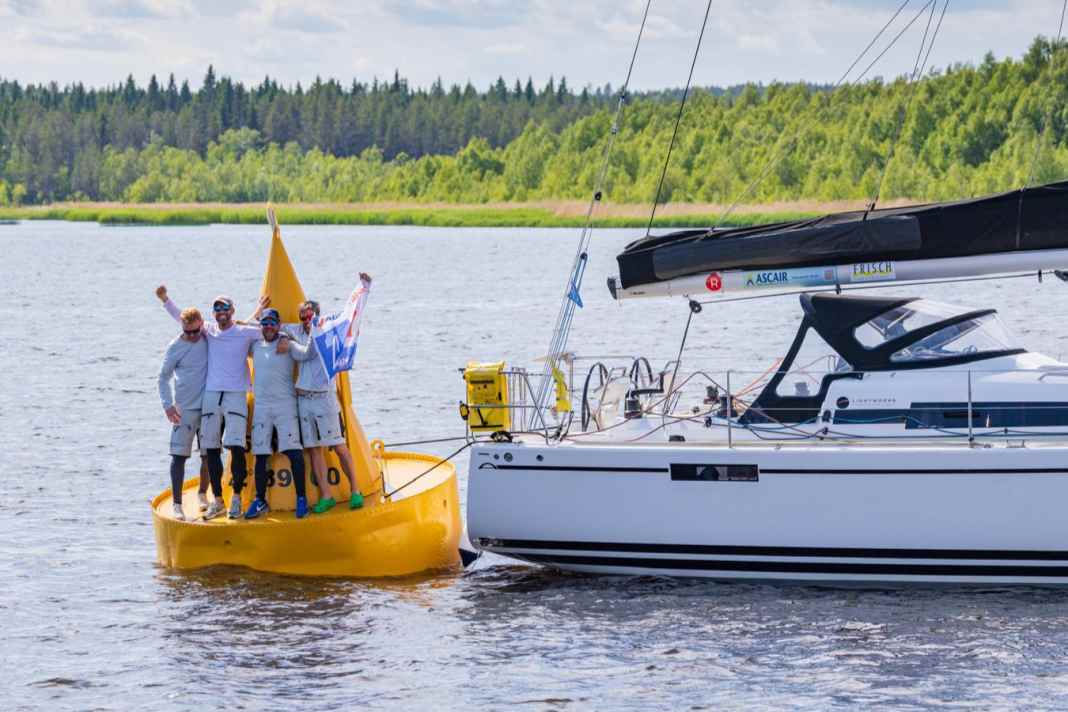





What the Kieler Woche participants experienced, the sea sailors in the 900 nautical mile marathon MidsummerSail also had to master on their course from Wismar to Töre in Sweden: wildly changing conditions. The race began in a lazy summer calm, turned into a southerly with winds of up to 40 knots and ended for the first boats almost as if nothing had happened.
10th MidsummerSail: Record chance shattered early
The first boat to cross the finish line of the tenth MidsummerSail on 27 June was the Danish Dragonfly 40 "Flying Dragon". The 12.40 metre trimaran carried skipper Jens Thuessen, Tor Beltor and Jens Quorning from south to north in 5 days, 19 hours, 54 minutes and 23 seconds. The crew had to contend with strongly changing wind directions and forces. The chance of setting a new record time across all classes for the longest Baltic Sea race was dashed early on in the race by the initially too light winds in this anniversary edition.
Mathias von Blumencron's former Class40 "Red" still holds the record, which his team mastered in 2022 in 4 days, 19 hours, 7 minutes and 46 seconds. Skipper Mathias Müller von Blumencron, Felix Oehme and Wolf Scheder achieved the record at the time. In the same year, "Flaneur" was the fastest multihull to reach the finish line after 5 days, 38 minutes and 16 seconds. This record still stands.
This year's Monhull Line Honours went to Michael Höfgen's Arcona 385 "Lightworks" (Flensburger Segel-Club). Together with Jasper Marwege, Lutz Orgelmann and Bastian Körbes, skipper Michael Höfgen mastered the course in 6 days, 58 minutes and 36 seconds after a light wind final. "We pushed like crazy until the last minute," reported Michael Höfgen after crossing the finish line and the classic photo with the crew on the famous yellow Töre buoy.
Finnish "electricity lessons" at the MidsummerSail
Höfgen's sporting summary after some stormy conditions: "When Bornholm the tri capsisedI also thought that our boat was going to fly apart. Our crew worked really well and it was a lot of fun overall. I wouldn't have thought that a 38-foot boat would be the first monohull to finish."
Michael Höfgen and his crew have also learnt an exciting lesson from this Baltic Sea marathon: "In between - I think near Vaasa - we crossed over to the Finnish side. There was a current that made me think my instruments were going crazy. We had a drift of 40 degrees! I thought something must be wrong. I thought: Where is this water coming from? Then I learnt that fresh water comes from the Finnish mainland. That's why the salt content there is so low. That was totally amazing. I've never experienced anything like it."
During this phase, the pursuers on the 12.10 metre long "MadameX2" were able to make up some ground on Michael Höfgen's 11.28 metre long Arcona. "We must have lost ten nautical miles to the others. If we had interpreted that correctly, we might even have got the tri. That's a bit of self-criticism," said the "Lightworks" skipper. André Engelke's "MadamX2" crossed the finish line around one and a half hours after the "Lightworks" as the third boat and second monohull.
MidsummerSail: first the race, then the summer cruise
Overall, Michael Höfgen's conclusion was positive: "We had all conditions: We had light, medium and strong winds. We rocked through the whole programme once and it went really well." According to the ambitious and experienced regatta sailor, he wanted to do something other than "just sail around the buoys", which is why he had signed up for the MidsummerSail with old friends. For Michael Höfgen, like many other crews, the regatta experience is followed by a summer cruise with his family. "That's a very nice opportunity that the race offers."
The fact that 35 out of 83 boats are listed as "Retired" this year was mainly due to the strong and stormy winds at the beginning of the week. Click here for an overview of all boats in the current edition. Hasso Hoffmeister's Akilaria 950 "Whiteout" with his co-sailors Sven Winterberg, Fabian Buhse and Anika Lippert was expected to be the fourth boat at the yellow MidsummerSail buoy on Friday evening. Click here for the tracker and an overview of the field.

